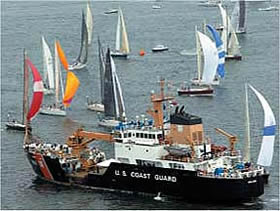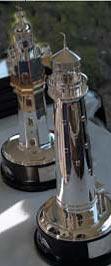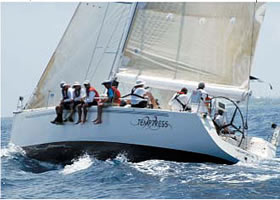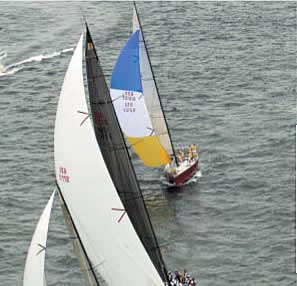 |
|
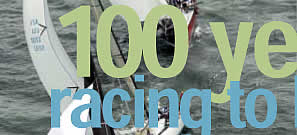 |
 |
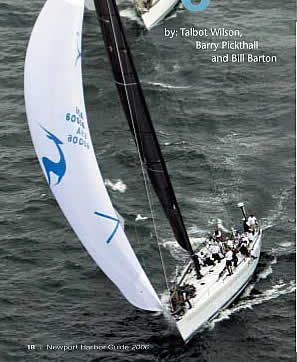 |
|
|
dangers of the deep? If they make a voyage from Larchmont to Cow Bay in a 10 knot breeze, it is the event of their lives, an experience they never forget and never want to repeat.” These comments on the pages of his magazine did wonders for promoting the concept of racing small boats beyond the horizon. After the Hampton Roads Race, which had attracted nine yachts, owners turned to Day for something more ambitious. They wanted “a real ocean race, one that would take them well offshore and into blue water.” The Rudder editor needed little encouragement to push for a new event. The Brooklyn Yacht Club organized the start and encouraged participation. English yachting enthusiast Sir Thomas Lipton provided the £100 Cup for the winner. The Royal Bermuda Yacht Club, under the leadership of Commodore Ambrose Gosling, organized the finish line and assessed their members £2.00 each for post-race entertainment. And the race to Bermuda was born. The criticism within the press was vociferous and the public campaign led some to send memorial wreaths and undertaker’s cards to crewmembers that planned to enter the race. Despite this, three yachts, Lila, Gauntlet and Tamerlane appeared for the start in Gravesend Bay at 3pm on Saturday May 26, 1906. Soon after, Lila suffered rigging damage and was forced to return, accompanied by Tamerlane whose crew set out again for Bermuda the following Tuesday. This 38ft yawl owned by Commodore Frank Maier of the Eastern Yacht Club also carried editor Day onboard. He reported in the July issue of Rudder, of an uneventful passage that took 5 days, 6 hours and 9 minutes—an average of 5.22 knots. According to Alfred Loomis, Gauntlet did not see the mishap and went on to be caught in a gale in the Gulf Stream, making a very stormy passage and being blown far to the east of the rhumb line to the islands. Lila gave up on her second attempt in the stream and went home.
Frank Maier's 38' yawl Tamerlane with Thomas Fleming
Day in command won the first Bermuda Race in 1906. Photo from "The
Rudder." Pros Allowed In 1907 restrictions were relaxed and professionals were allowed to sail, but amateurs formed the afterguard. With twelve boats at the start in Gravesend Bay, Dervish won the large class and Lila took the small class. Thomas Day powered to Bermuda in a motorboat. Marblehead Start After a successful race in 1907 with twelve yachts on the line, the 1908 race started from Marblehead with five. Dervish won her class again. The 43.5 foot waterline length Verona won her class and beat the larger 56-foot Dervish across the line at St. David’s Bermuda by ten hours on elapsed time. Five boats started once again from Gravesend Bay in 1909, Amorita, a 79-foot schooner crossed first in 3D:6H:19M but was beaten on corrected time by the schooner Margaret. The WWI Years The years leading up the war and the war years forced so many big yachts to be laid up that only two yachts, Harold S. Vanderbilt’s 62ft Herreshoff schooner Vagrant, and Demarest Lloyds’s 50 footer Shiyessa made it for the start of the 1910 race and the event almost died. It was a match race to Bermuda where Vagrant caught a wind shift just north of Bermuda and nipped Shiyessa on corrected time by forty-eight minutes. This was the last Bermuda Race until after WWI. The 1920’s The idea of racing small boats to Bermuda was not revived until 1920 when the Royal Bermuda Yacht Club began attempts to restart the series. Although a race was announced for the spring of 1920, Bermuda’s Royal Gazette says that the race would be postponed until at least June of 1921. The next mention in the Gazette in April 1922 is of the possibility of a race between New York and Bermuda that summer. Eldon Trimmingham, then Vice Commodore of the Royal Bermuda Yacht Club, went to meet with the New York Yacht Club as the representative of the club’s Board of Governors to promote the race, but could not obtain sufficient entries. For 1923, the RBYC Sailing Committee found support from Yachting magazine and some prominent yachtsmen like John Alden. A group of the new Cruising Club of America sailors led by Herbert L Stone, editor of Yachting, took up the challenge and the race was reborn. Start in New London Out of the thirty-two entries that had been received in 1923, twenty-three yachts came to the line off New London, Connecticut. Royal Bermuda Yacht Club, the New Haven Yacht Club and Yachting Magazine donated cups for the three classes. Paul Hammond, vice-commodore of the Seawanahaka Corinthian Yacht Club gave one for the first yacht finishing with an all-amateur crew. Alfred Loomis writes in Ocean Racing, “In all this [the 1923 race] the Cruising Club of America took no official part, although when the day [for the start] came its membership migrated to Bermuda almost en masse…all but one of its six members embarked in five different racing boats.” The one who stayed behind started the race. The Royal Gazette says that Herbert Stone mentioned that the boats were manned almost entirely by amateurs, making this Bermuda Race the first ocean race of any kind not dominated by professionals—a concept that continues to this day. The 1923 fleet was caught by a storm, which simply added to the fascination and folklore that has built up around this race over the years. All of them made it in one piece, led by Robert N. Bavier’s yawl Memory. Judge Coffin, the skipper of Seafarer, summed up the conditions best in his oft quoted statement, “The next time I come to Bermuda it will be in a submarine. Then I can be under water all the time instead of half under all the time.” The 1924 race began off of Sarah’s Ledge at New London with fourteen entries. It attracted the important challenge from the English aboard Northern Light and Jolie Brise. Their skippers, Weston Martyr and George Martin, so enjoyed the event that they returned home later that summer determined to set up an Ocean Racing Club in London (now known as the Royal Ocean Racing Club) and to host an ocean race on the other side of the Atlantic—the 605 mile Fastnet, which was run for the first time in 1925. With the decline to fourteen entries in the last race, due probably to time constraints and cost, the series became biennial. Sixteen entries came to the line in 1926; and with a gain of only two from the previous race, the year was critical for the future of ocean racing to Bermuda. Although its members were active in the races, The Cruising Club of America did not formally participate in running the 1923 or 1924 races because it was founded in a protest against racing. The club agreed to co-host the 1926 Bermuda Race despite being roundly admonished by some of its membership who believed the Club should be doing what its title suggests, and not promoting racing. CCA IN The progressives won that argument and the Cruising Club continues to this day to coordinate the race in partnership with the Royal Bermuda Yacht Club. Loomis points out in Ocean Racing that bad weather in this year would have been a “solar plexus blow” to the race. “But,” Loomis continues, “the weather god was kind; the Cruising Club assimilated its critics, and the crisis passed. The Bermuda Race has rightly been regarded in the years since as a fixture which only a war can disrupt.” The Bermuda Race continued to prosper under the partnership between the Royal Bermuda Yacht Club and the Cruising Club of America as the race sought a permanent starting port. In 1928 the start was from New London with twenty-four yachts, in 1930 it saw 42 yachts start from New London again. In 1932 the depression diminished the fleet to 27 entries starting from a new line off Montauk Point. The start in 1934 was moved back to Sarah’s Ledge since the Point was far from last minute supplies. The fleet increased to twenty-nine. Start Moves to Newport In 1936 the Cruising Club and Royal Bermuda agreed to move the start to Newport, Rhode Island to avoid the unpredictable winds and the strong tides of Long Island sound. Despite the Depression, a record breaking fleet of forty-four yachts including nine international entries came to the line. Unfortunately, ten boats, also a record number, failed to finish as a storm hit the fleet in the stream with 40-50 knot winds.
|
With ten boats dismasted in 1936, the CCA undertook a review of safety regulations and led the way to establishing many of the rig and equipment regulations in place today in the ISAF Offshore Safety Regulations. The CCA also introduced a revised handicap system in 1938 and advised the yachtsmen to install modern radios for safety. In 1938 the US Coast Guard Cutter Cayuga accompanied the fleet as a further precaution. The change to Newport proved popular and 1938, in the shadow of WWII, there were still forty-three yachts entered. The first series of Bermuda Races had ended because of WWI. This was the last Bermuda Race of the series between the wars.
After WWII Racing resumed again in 1946 and with it came the entrance into the modern, post-war series. The Race Committee revised the rules to require four or more crew per yacht and to require that the “master” and navigator be amateurs and that the finish line could be crossed in either direction. Royal Bermuda Yacht Club decided to celebrate the resumption of the race by offering a sterling silver replica of Gibbs Hill Lighthouse to the overall winner of the race. Thirty-four yachts started in two classes. The sixteen-inch lighthouse replica went to the yacht Gesture, sailed by Howard Fuller. She sported one of the new nylon spinnakers and a fancy radio direction finder on her cabin top. A revised version of the CCA rating rule introduced in 1949 brought a new record fleet of fifty-four yachts to the line in 1950. The fleet was divided into three classes to encourage more small boats to enter. Olin Stephens helped sail his design Bolero to line honors in 3D:3H:32M. Although Mrs. Robinson, the newlywed wife of Gauntlet’s owner, had sailed in the inaugural 1906 race, women were not officially eligible to race until 1952. The class A entry Bloodhound had three women aboard including a lady navigator, Mary Blewitt. She guided Bloodhound to second place on corrected time. The rules were continually revised and in 1954 the finish line once again had to be crossed in a southerly direction. That year there were 77 starters representing the US, Great Britain, Cuba, Sweden, Bermuda and Argentina. The St.David’s Lighthouse Trophy The St. David’s Lighthouse trophy was commissioned for the 1954 race to replace the traditional Bermuda Trophy. Designed and crafted of sterling silver in England, this second lighthouse trophy has become the most coveted trophy in amateur ocean racing. For first on corrected time, Dan Strohmeier in Malay took home the first St David’s Lighthouse Trophy ever awarded.
1962 had to be one of the most unusual of the post war races. The schooner Nina caught a reaching breeze all the way to St David’s and crossed the line less than two hours after Northern Lights which was first to finish. A large boat had not won the Bermuda Race since 1950 and the last schooner to win was the Alden design Malabar X in 1932. Nina flew a ‘jenniker’ a cross between a genoa and a spinnaker, perhaps the forerunner to a modern code zero. Onion Patch In 1964, the event was integrated into a series of races dubbed ‘The Onion Patch Series’ (in deference to Bermuda’s once national crop), with 3-boat teams representing their countries a multi-race series. The first series attracted teams from the USA, Bermuda and Argentina, and became the model for similar events in the UK and Australia to support two other classics in the sailing calendar, The Fastnet and Sydney/Hobart races. Many great sailors and designers have cut their teeth on Newport/Bermuda Race since. German Frers Sr. encouraged an increasing number of South American owners to compete in his designs in the 50s and 60s, and his son German Frers, remains one of the dominant designers with seven winners to date, including the record-breaking maxi Boomerang II. Skippers The most successful skipper has been Carleton Mitchell, whose yacht Finisterre won the race outright in 1956, ’58 & ’60. John G. Alden carried off the Bermuda Trophy twice in 1923 & ’26 and Dick Nye did the same with yachts named Carina in ’52 and ’70. The last of his yachts, which won again in 1982 competed again in the 2004 race, skippered by Rives Potts Jr. from Westbrook CT. Famous sailmaker and America’s Cup skipper, Ted Hood, won a notable victory in 1968 with his One-tonner Robin, but one of the most notable victories of all time came in 1972 when the British crew on a production Swan Noryema survived a hurricane to lift the St David’s Trophy ahead of many purpose built racers. At the time, skipper Ted Hicks put their win down to the foresight of carrying goggles. “It was the only way any of us could see anything through all that spray,” he said.
Line Honors There is another race for line honors. This has been won in the past by such notables as Huey Long’s Ondine which set a 67 hour 58 minute record in ‘74, and the Australian maxi Bumblebee IV whose performance against the likes of Ondine and Kialoa II owned by fellow American Jim Kilroy in the 1980 race was the first stepping stone towards IOR maxi boat dominance by designer German Frers. Nirvana, then owned by Bermudan Marvin Green, sliced 5 hours 29 minutes off the record in 1982 sailing in the largest fleet to date of 182 entries, and this record stood until George Coumantaros and his 86ft Frers designed Boomerang II completed the course in 57 hours 31 mins 30 secs in 1996. Roy Disney’s Reichel-Pugh designed Pyewacket made the most of the close reaching conditions to complete the 635 miles in the record time of 53 hours, 39 minutes 22 seconds to set the record which it still holds. The Newport Bermuda Race now stands with the Fastnet, the Sydney-Hobart and the Transpac as one of the top four ocean races in the world. Organized by the Royal Bermuda Yacht Club from 1906 to 1924 with various US yacht clubs and from 1926 with the Cruising Club of America, the Bermuda Race has always been a true test of blue-water sailing skills. The objectives of the race are to encourage the designing, building and sailing of seaworthy yachts and the development of the art of seamanship and proficiency in the science of navigation. © 2006 Newport Harbor Guide. All rights reserved. return to Newport Harbor Guide Articles |
| Newport Harbor Guide: home harbor watch directory map articles media kit contact | |

